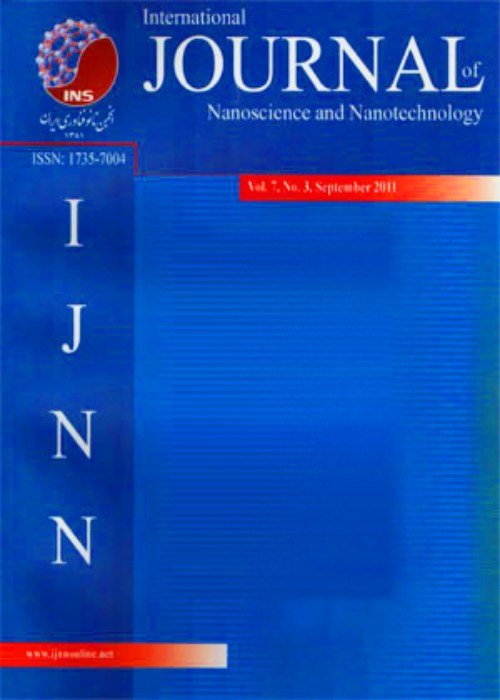فهرست مطالب
International Journal Of Nanoscience and Nanotechnology
Volume:9 Issue: 1, Winter 2013
- تاریخ انتشار: 1392/06/15
- تعداد عناوین: 7
-
-
Pages 3-6In this study، magnetic nanoparticles (γ-Fe2O3) were used for the degradation of 2-chlorophenol (CP) from wastewater. The size of these magnetic nanoparticles was measured using XRD and found to be aboutKeywords: Nanoparticle, 2, Chlorophenol, Ultrasound irradiation, Wastewater, Degradation
-
Pages 7-14A facile co-precipitation method for the synthesis of well-dispersed NdFeO3 nanocrystals is developed in the presence of octanoic acid as surfactant. Co-precipitation can produce fine, high-purity, stoichiometric particles of single and multicomponent metal oxides. The product is characterized by Fourier transform infrared spectroscopy (FT-IR), X-ray diffraction (XRD), scanning electron microscopy (SEM), and energy dispersive X-ray spectrometer (EDX). The XRD analysis shows only the pattern corresponding to perovskitetype NdFeO3 which crystallizes in the orthorhombic system. The spherical NdFeO3 nanocrystals with an average particle size of about 69 nm can be obtained at a relatively high calcining temperature of 800°C. Also, sphere-like NdFeO3 nanocrystals obtained by this method are uniform in both morphology and particle size. The results indicate that the amount of surfactant, pH and rate of stirring have an important role in the homogeneity and size of product. The preparation process can be also applied to synthesize other metal oxides.Keywords: Nanocrystals, Co, precipitation, Octanoic acid, Perovskite, NdFeO3
-
Pages 15-24Quantum-dot Cellular Automata (QCA) has low power consumption and high density and regularity. QCA widely supports the new devices designed for nanotechnology. Application of QCA technology as an alternative method for CMOS technology on nano-scale shows a promising future. This paper presents successful designing, layout and analysis of Multiplexer with a new structure in QCA technique. In this paper we generalize a 2 to 1 multiplexer, which is used as module to implement the 2n to 1 multiplexer. In this paper, we will present successful simulation of the 2 to 1, 4 to 1 and 8 to 1 multiplexer with QCA Designer. We will design a new multiplexer based on the majority gate with the minimum number of cells and consumed area. Being potentially pipeline, the QCA technology calculates with the maximum operating speed. We may usethese multiplexers in the FPGA and ALU.Keywords: Majority gate, Module, Multiplexer, Quantum, dot cellular automata(QCA)
-
Pages 25-32The influence of nanoclay on the impact damage resistance of glass fiber–epoxy composites has been investigated using high-velocity repeated ice impact tests. The incorporation of nanoclay into epoxy enhances the impact resistance of the composites. The impact of ice is a realistic scenario for composite structures such as aircraft fuselages, wing skins and fan blades and it is not a completely understood threat. Repeated ice impact events, such as the ones during a hailstorm, can cause significant damage. This work focuses on repeated ice impact experiments and damage in composite and nanocomposite materials. X-ray diffraction analysis confirmed the exfoliation and intercalation of the nanoclay in the studied epoxy resin system. The result shows that plates with a fiber orientation of [45°/45°]s in the composite produce the minimum delamination and that a small amount of nanoclay is enough to improve the mechanical properties of the nanoclay-polymer nanocomposites.Keywords: Nanocomposites, Ice impact, Damage assessment, Nanoclay, Damaged areas
-
Pages 33-38In this work, the strontium-doped lanthanum manganite- a ceramic material- used as cathode in solid oxide fuel cells. An impression of grinding time on the structural and thermal properties of Sr-doped LaMnO3 system with La1-xSrxMnO3 (x=0.2) stoichiometric ratio was investigated. The nano crystallite LSM powder with cubic structure was prepared by varying the milling time of planetary monomill during the mechanochemical method. XRD diffraction patterns confirmed that increasing milling time has effect on phase structure, sintering and thermal behavior of LSM. The optimum sintering temperature was determined and then thermal treatments were investigated with Differential Thermal Analysis (DTA) and Thermal Gravimetric Analysis (TGA) methods, respectively. The results of this research certainly indicated that by increasing grinding time as an important factor in LSM mechanochemical synthesis, the nanocrystallite size and distribution as well as thermal characteristics will be modified.Keywords: Solid oxide fuel cell, Strontium, doped lanthanum manganite, Mechanochemicl synthesis, Cathode material, Nanocrystallite, Phase structure
-
Pages 39-50In this paper, the effect of air relative humidity and capillary force on contact geometry of surfaces based on JKR model by Atomic force microscopy was investigated in order to manipulate nano-particles. With transition from macro to nano-scale, the effect of surface forces becomes more significant in comparison with inertial force. Because contact mechanics models are based on surface energy and there is a permanent humidity in surrounded environment. In order to precisely determine the forces in AFM dynamics equations and different environments and also their application in contact modeling, the effect of capillary forces must exactly be specified. Experimental results showed that the air relative humidity percentage affects the adhesion force. So, as AFM is used for fine and nano-scale particles. These forces have significant effect on operation accuracy and should not be neglected. In this paper, the effect of capillary forces has been modeled based on JKR contact mechanics model. The results obtained from this modeling have been compared with experimental data.Keywords: AFM, nano, manipulation, Relative humidity, Capillary force, Adhesion force, Contact models
-
Pages 51-58In this scientific research work we report a novel method to synthesis Co3O4 nanoparticles via calcinations of cobalt hydroxide which can be conveniently prepared by the Co(NO3)2.6H2O with different reactants. In order to study the effect of calcination temperature on structure and morphology of the nanoparticles, the calcinations take place at various temperatures (at 300°C, 500°C and 700°C). The nature of cobalt oxide species depending on heat treatment. The samples at low temperature show decrease on size and dimension. The characteristics of the nanoparticles were investigated by XRD patterns, IR spectroscopy and scanning electron microscopy (SEM). It indicates that at higher temperature, greater nanoparticles were produced. Decomposition of H2O2 showed that calcination at 300°C result to higher activity.Keywords: Cobalt oxide, Microemulsions, Nanoparticles, Hydrogen peroxide, Calcination temperatures


